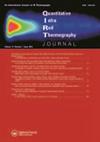Feature analysis for drowsiness detection based on facial skin temperature using variational autoencoder : a preliminary study
IF 4.9
3区 工程技术
Q1 INSTRUMENTS & INSTRUMENTATION
引用次数: 1
Abstract
ABSTRACT Technology to detect signs of drowsiness in drivers is essential even in the age of automated driving to prevent traffic accidents. In this study, facial skin temperature, which can be measured remotely using infrared thermography, as a measure for determining drowsiness was in focus. Facial skin temperature is an autonomic nervous system index that depends on skin blood flow. It is known that facial skin temperature changes depending on the physiological and psychological state, and that it is affected by drowsiness. We focused on an anomaly detection algorithm called the variational autoencoder (VAE). In this study, a model to detect drowsiness was constructed using VAE with only the facial skin temperature during arousal from sleep and search was made for facial areas where skin temperature fluctuates with drowsiness using the model. As a result, it was found that the side of the nasal dorsum may fluctuate with drowsiness and that facial skin temperature may fluctuate asymmetrically with drowsiness. Skin temperature around the orbit was shown to be an area of possible physiological and psychological significance related to autonomic nervous system activity. Based on the above, the degree of anomaly was confirmed to vary depending on the degree of drowsiness, indicating the usefulness of using VAE for drowsiness detection based on facial skin temperature.基于变分自编码器的面部皮肤温度困倦检测特征分析:初步研究
本文章由计算机程序翻译,如有差异,请以英文原文为准。
求助全文
约1分钟内获得全文
求助全文
来源期刊

Quantitative Infrared Thermography Journal
Physics and Astronomy-Instrumentation
CiteScore
6.80
自引率
12.00%
发文量
17
审稿时长
>12 weeks
期刊介绍:
The Quantitative InfraRed Thermography Journal (QIRT) provides a forum for industry and academia to discuss the latest developments of instrumentation, theoretical and experimental practices, data reduction, and image processing related to infrared thermography.
 求助内容:
求助内容: 应助结果提醒方式:
应助结果提醒方式:


